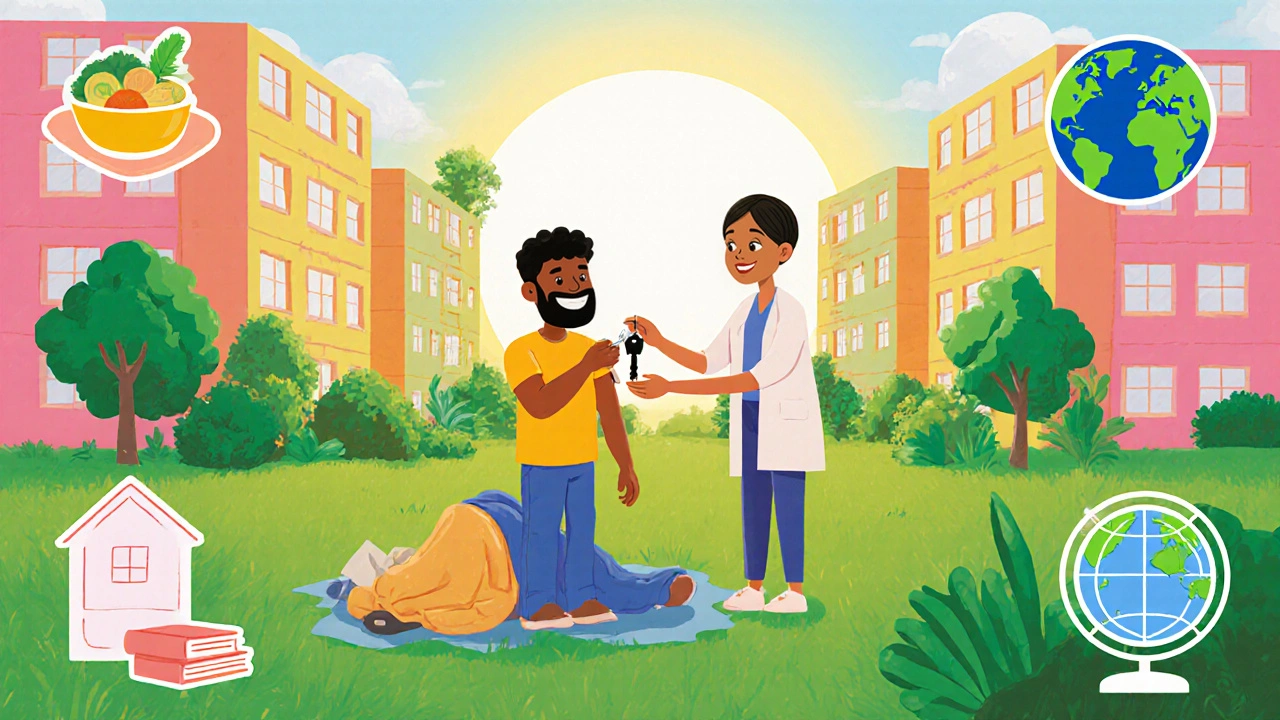The link between leprosy and homelessness often flies under the radar, yet it shapes health outcomes for millions worldwide. By unpacking the biology of the disease, the social forces that push people onto the streets, and the policy responses that matter, we can see why this pairing is a pressing global issue.
What is leprosy?
Leprosy is a chronic infectious disease caused by Mycobacterium leprae. The bacterium attacks skin, peripheral nerves, and mucous membranes, leading to skin lesions, numbness, and, if untreated, permanent disability. According to the World Health Organization (WHO), there were roughly 127,000 new cases reported in 2023, with the majority concentrated in low‑ and middle‑income nations.
How homelessness amplifies risk
Homelessness isn’t just a lack of shelter; it represents a web of social determinants that raise exposure to leprosy. Overcrowded shelters, limited access to clean water, and delayed medical care all boost transmission chances. A 2022 study in Brazil showed that homeless individuals were three times more likely to develop leprosy than housed peers, highlighting how poverty, migration, and stigma intersect.
Types of leprosy and why they matter
Leprosy presents along a spectrum. The two polar forms-tuberculoid and lepromatous-carry different clinical and epidemiological implications. Below is a quick side‑by‑side look.
| Attribute | Tuberculoid leprosy | Lepromatous leprosy |
|---|---|---|
| Immune response | Strong cell‑mediated immunity | Weak cell‑mediated immunity |
| Skin lesions | Few, well‑defined plaques | Numerous, diffuse nodules |
| Contagiousness | Low | Higher, especially in crowded settings |
| Treatment duration | 6-12 months | 12-24 months |
Both forms are treatable with Multidrug therapy (MDT), the WHO‑endorsed regimen that combines dapsone, rifampicin, and clofazimine. Early detection is key, but homelessness often stalls diagnosis.

Key social determinants that drive the connection
- Overcrowded living conditions in shelters or informal settlements.
- Limited access to routine health screenings.
- Stigma that discourages people from seeking care.
- Unstable nutrition, which weakens immunity.
- Migration patterns that move infected individuals across borders.
Stigma around leprosy can be as damaging as the disease itself. In many cultures, visible skin lesions trigger fear, causing families to hide affected members. When a person feels shunned, they’re less likely to report symptoms-fueling hidden transmission cycles, especially among homeless populations who already lack a support network.
Global snapshots: How different regions confront the challenge
India reports over half of global leprosy cases. Initiatives like the “National Leprosy Eradication Programme” now integrate mobile clinics that visit homeless encampments, offering free skin checks and MDT.
Brazil faces a dual burden of urban homelessness and endemic leprosy. Partnerships between municipal health departments and NGOs have introduced “one‑stop” health hubs where shelter residents receive immunizations, wound care, and leprosy screening in a single visit.
East Africa, particularly Ethiopia and Kenya, sees leprosy flare‑ups in refugee camps where crowding and limited sanitation are common. The Integrated care programs deployed by the WHO focus on training camp health workers to spot early signs, reducing the average detection delay from 18 months to under six months.
Public‑health strategies that actually work
Effective responses blend medical treatment with social support:
- Active case finding: Deploy outreach teams to shelters, street clinics, and migrant centers.
- Community education: Use peer educators to debunk myths about leprosy, reducing stigma.
- Housing‑first models: Secure, stable housing dramatically improves treatment adherence.
- Nutrition programs: Supplementary feeding boosts immune function, lowering disease severity.
- Policy integration: Align leprosy services with broader HIV, TB, and mental‑health programs to optimize resources.
Countries that have adopted at least three of these pillars report a 40‑% drop in new leprosy cases among homeless cohorts within five years.

Checklist for NGOs and health workers
- Ensure every outreach device carries MDT stocks for immediate dispensing.
- Train shelter staff to recognize early skin lesions and nerve loss.
- Provide confidential counseling to address stigma.
- Link diagnosed individuals to stable housing before initiating treatment.
- Monitor treatment completion rates and follow up within two weeks of each dose.
Following this simple list can turn a scattered effort into a coordinated eradication push.
Looking ahead: What needs to change?
The battle against leprosy isn’t just about antibiotics; it’s about breaking the cycle of poverty, displacement, and discrimination. Future policies must:
- Allocate dedicated funding for street‑level health services.
- Integrate leprosy metrics into broader homeless health dashboards.
- Scale housing‑first initiatives that guarantee a safe place to complete therapy.
- Support research on rapid diagnostic tools that can be used in low‑resource settings.
- Champion global advocacy to keep leprosy on the public‑health agenda, even as other diseases dominate headlines.
When the world recognizes that a disease once thought eradicated still thrives in our most vulnerable corners, we can finally close the gap between medical cure and social justice.
Frequently Asked Questions
Can leprosy be cured?
Yes. Multidrug therapy (MDT) cures >95% of cases when taken as prescribed. Early diagnosis shortens treatment time and prevents disability.
Why are homeless people at higher risk?
Overcrowded shelters, limited access to healthcare, poor nutrition, and stigma all increase exposure and delay treatment, making the disease spread more easily.
Is leprosy contagious?
It spreads mainly through prolonged close contact with untreated patients, especially the lepromatous form. Casual contact poses minimal risk.
What role does stigma play?
Stigma discourages people from seeking care, leading to late diagnosis and ongoing transmission, particularly in homeless settings where community support is already thin.
How can communities help?
Support local shelters, volunteer for health outreach, and spread accurate information about leprosy and its treatment to break myths and encourage early testing.







Kirsten Youtsey
It is evident that the discourse surrounding leprosy and homelessness is often sanitized, hiding the underlying power structures that perpetuate neglect. The author glosses over the systemic exploitation that fuels both poverty and disease, presenting data without probing who benefits from the status quo. One must question whether the cited studies are independently verified or merely reproduced from agencies with vested interests. Moreover, the omission of any critique of global pharmaceutical policies raises suspicions about the narrative’s completeness. In truth, without confronting these hidden agendas, any proposed solutions remain superficial.
Deja Scott
While the analysis raises important points, it is essential to also highlight community-driven successes that have emerged despite such constraints.
Natalie Morgan
Leprosy isn’t a relic of the past it’s a present reality especially among those without roofs over their heads The disease spreads quickly in cramped shelters where hygiene is compromised but early detection can turn the tide The WHO’s multidrug therapy works wonders if delivered promptly so outreach teams must prioritize street clinics and mobile units Together we can break the cycle of stigma and infection
Mahesh Upadhyay
The tragedy is real – people die in the shadows while we talk statistics.
Rajesh Myadam
Your observation hits home. Many affected individuals simply lack a voice, and our silence only deepens their suffering.
Israel Emory
We must act now, because every day of delay costs lives, every missed screening fuels transmission, and every ignored call for funding widens the gap-let’s mobilize resources, empower shelters, and enforce comprehensive health policies, pronto!
Sebastian Green
I feel the urgency you describe. Providing stable housing can truly improve treatment adherence.
Wesley Humble
Statistically speaking, the prevalence of leprosy among homeless populations exceeds expectations by a factor of three, as evidenced by the 2022 Brazilian cohort study. This datum unequivocally demonstrates a correlation that cannot be dismissed as coincidental. Accordingly, policymakers ought to allocate targeted resources to street-level health interventions 😊. Failure to do so would constitute a dereliction of public‑health duty.
jessie cole
Trust me, the path forward is clear. Deploy mobile clinics, train shelter staff, and secure housing – these steps will save lives. Together we can turn despair into hope.
barnabas jacob
Yo, the whole leprosy‑homelessness nexus is a classic case of social‑determinant failure, man. We need big‑data surveillance plus grassroots outreach, no doubt. If we don’t scale up, the morbidity rates will keep climbing.
Vijaypal Yadav
Indeed, the epidemiological models predict a steep rise without intervention. Early case finding remains the cornerstone of control.
Ron Lanham
The moral imperative to address leprosy among homeless populations cannot be overstated. First, we must acknowledge that disease does not respect socioeconomic borders. Second, the existing health infrastructure in many low‑income regions is woefully inadequate. Third, stigma operates as an invisible barrier that prevents individuals from seeking care. Fourth, without stable housing, even the most effective multidrug therapy will falter. Fifth, nutritional deficits weaken immune responses, making infections more severe. Sixth, migration patterns disperse pathogens across borders, complicating surveillance. Seventh, governments frequently allocate insufficient budgets to street‑level health services. Eighth, NGOs often fill the gap but lack the sustained funding needed for long‑term impact. Ninth, community education must be culturally sensitive and delivered by trusted peers. Tenth, integration of leprosy services with broader health programs maximizes resource efficiency. Eleventh, data collection should be standardized to monitor treatment adherence accurately. Twelfth, innovative diagnostic tools could revolutionize early detection in resource‑poor settings. Thirteenth, housing‑first models have demonstrated success in improving health outcomes across multiple diseases. Finally, a coordinated global effort, backed by political will and adequate financing, is essential to eradicate this preventable scourge.
Andrew Hernandez
Integrating leprosy metrics into existing homeless health dashboards offers a pragmatic solution.
Alex Pegg
International agencies often impose one‑size‑fits‑all policies that ignore local realities, and that approach must be challenged.
JessicaAnn Sutton
Neglecting leprosy among the homeless is an indefensible public‑health failure.